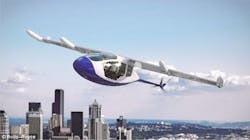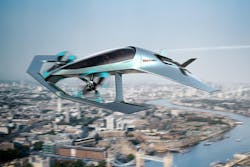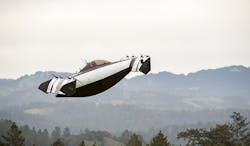Rolls-Royce, Aston Martin Join Race for Autonomous Flying Cars
The number of companies working on flying cars is proliferating at a fast and furious pace. Last week, aerospace giant Rolls-Royce threw its hat into the ring, unveiling a concept electric vertical takeoff and landing (eVTOL) vehicle at the Farnborough International Airshow in the UK. The hybrid-electric vehicle sports six electric props and features wings that rotate 90 degrees to enable vertical takeoff and landing, eliminating the need for a runway (Fig. 1).
1. The forward wing rotates 90 degrees to enable vertical takeoff and landing. (Source: Rolls-Royce)
Incidentally, this version of Rolls-Royce makes commercial jet engines. The luxury carmaker Rolls-Royce Motor Cars isn’t associated with the effort to create a flying car and is owned by German car manufacturer BMW.
The concept vehicle uses Rolls-Royce’s M250 gas turbine engines to generate electricity, delivering around 500 kW to six electric props designed to have a low noise profile, according to the company. The hybrid eVTOL would carry four to five passengers with speeds up to 250 mph for about 500 miles (800 km) using the gas turbine to charge the battery. Once the craft reaches its cruising altitude, its vehicle’s lifting propellers fold away and the craft would rely on its rear propellers for thrust. The company said its prototype will take to the skies before the end of 2019.
Rolls-Royce reported that to date, its M250 gas turbine has chalked up more than 250 million operating hours, powering more than 170 different helicopter and fixed-wing civil and military aircraft.
Aston Martin’s Volante
Last week, too, British luxury car brand Aston Martin presented its Volante Vision Concept aircraft with eVTOL capabilities. Described as a near future study that previews a flying hybrid-electric vehicle for urban and inter-city air travel, the small craft offers room for three adults, and can operate in autonomous mode (Fig. 2). Produced in partnership with Cranfield Aerospace Solutions, Cranfield University, and Rolls-Royce, the concept aircraft aims to bring fast, efficient, and luxury urban transportation to the sky, according to Aston Martin.
2. Aston Martin’s Volante Vision Concept aircraft seats three and can operate in autonomous mode. (Source: Aston Martin)
“Humans have always spent on average, one hour commuting to and from work,” says Aston Martin President and CEO Dr. Andy Palmer. ”The distance we live from our workplace has been determined by the methods of transportation available. The Volante Vision Concept will enable us to travel further with our hourly commute, meaning we are able to live further away from where we work. Cities will grow, and towns that are today too far away from cities to be commutable will become suburban.”
A number of other firms already are working on autonomous flying vehicles. They include archrival commercial airplane makers Airbus and Boeing, as well as Uber and a range of new entrants such as Kitty Hawk and Opener—flying-car startups created by Google cofounder Larry Page.
Opener’s BlackFly
On July 8, Opener unveiled its BlackFly single-seat “personal aerial vehicle” (PAV). The prototype eVTOL is a tandem-wing, eight-rotor craft that already has taken to the air more than 1,400 times, with the total distance flown exceeding 12,000 miles, according to its manufacturer (Fig. 3). The aircraft can travel up to 25 miles at 62 mph in the U.S. Its drivetrain uses eight fixed propulsion units with four redundant elevon pairs, and a ballistic parachute is optional.
3. Opener’s single-seat eVTOL BlackFly can fly 25 miles at 62 mph. (Source: Opener)
Weighing in at just 313 lb. empty, BlackFly can carry a maximum payload of 250 lb. with an 8-kWh battery pack in the U.S., or 12 kWh for the rest of the world (where top speed is boosted to 80 mph). Its maximum climb rate and descent are set to 1,000 feet per minute. BlackFly can take off and land in just 36 inches of space (about 91 centimeters), according to Opener.
Depending on which charging system is used, a slow charge can take up to 7½ hours; a dedicated 240-V charger delivering 2×50 A cuts this time to 25 minutes. Range with reserve is expected to be 25 miles in the U.S. and over 40 for the rest of the world.
According to BlackFly, the company will require no formal licensing in the U.S.
Boeing and Airbus
Not wanting to be left behind in the emerging autonomous flying-taxi business, last year the Boeing Co. acquired Aurora Flight Sciences, which continues its active research into commercial eVTOL systems and is one of Uber’s air-taxi partners. Uber plans to use electric flying taxis for its Uber Elevate ride-hailing service scheduled to make its debut in Dallas-Fort Worth and Dubai in 2020.
For its part, Airbus has been testing an all-electric autonomously controlled eVTOL prototype called Vahana at Oregon’s Pendleton UAS Test Range (PUR), which offers both conventional and unconventional takeoff and landing capability from the Eastern Oregon Regional Airport (KPDT). Vahana has a battery range of 100 km and is being built with the idea that passengers would use smartphone apps to book rides.




